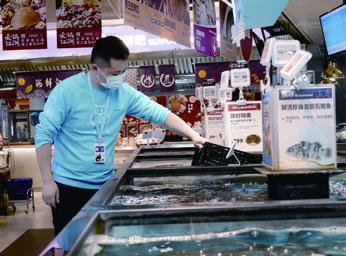From Marsh to Miracles
2020-11-20ByJiJing
By Ji Jing
When guests from around the world arrived at the Shanghai Pudong International Airport recently to participate in the Third China International Import Expo (CIIE), few could have imagined that this bustling aviation hub on the bank of the Yangtze River used to be a tidal fl at till the late 1990s.
Shanghais Pudong and Puxi areas, though separated only by the Huangpu River, used to be dissimilar like chalk and cheese. Puxi was prosperous while Pudong was all villages and farmland before the 1990s. There was an old saying in Shanghai: Its better to have a bed in Puxi than a house in Pudong.

In the past three decades, Pudong has developed into one of the countrys most prosperous areas. On November 12, a grand gathering was held in Shanghai to celebrate the 30th anniversary of the areas development and opening up. At the gathering, President Xi Jinping called on Pudong to play new roles and accomplish new missions in Chinas new march to build a great modern socialist country. In particular, he urged for major innovations in science and technology.
The Central Government made the decision to develop and open up Pudong in April 1990.
It was not a sudden decision. In the 1980s, the Communist Party of China (CPC) and the government had the idea of developing Pudong to address the problems hindering Shanghais development—traffi c congestion, housing scarcity and lack of development space.
It was a strategic decision. Shen Kaiyan, Director of the Institute of Economics at the Shanghai Academy of Social Sciences, told Shanghai-based Xinmin Weekly, “It was a crucial step for aligning China with the rest of the world. The move indicated Chinas determination to go ahead with reform and opening up.”
In 1990, Pudong New Area was established and from there, a modern new economic center emerged from farmland. Today, Pudong, which accounts for only about 0.01 percent of Chinas territory, produces 1 percent of the countrys GDP and 6 percent of the national import and export value.
Financial hub
Since 1994, Yao Jianliang has been taking panoramic photographs of Lujiazui, a fi nan-cial hub in Pudong, from a city landmark, the 468-meter Oriental Pearl Radio and TV Tower that is the fourth highest tower in Asia. It became an annual task for him to document the changing face of Lujiazui with his birds-eye-view images. When the China Art Museum in Pudong opened a month-long exhibition, Wind From the East, on October 30 to shine a light on three decades of change, Yaos photographs were part of the collection.
In the first photo, Lujiazui was full of one-story houses. Following the launch of the policy to open up Pudong, the government decided to build a new trade and fi nance center in Lujiazui. Yao said he used to wonder how such a backward place could be turned into a fi nancial hub.
Today, the Lujiazui Finance and Trade Zone is dominated by skyscrapers. Though it has an area of only about 31.78 square km, it houses more than 6,000 financial institutions and over 300,000 fi nancial professionals. Of its 285 commercial buildings, the occupants of 102 buildings pay taxes of over 100 million yuan ($15 million), 30 over 1 billion yuan ($152 million) and four over 5 billion yuan ($758 million).
In the 1990s, the Shanghai Stock Exchange (SSE) and the Shanghai Futures Exchange were established in Pudong and a national-level fi nancial market took shape in Shanghai.
Entering the 21st century, with the establishment of the Shanghai Gold Exchange and the China Financial Futures Exchange, Pudongs fi nancial market further expanded. Shanghais fi nancial industry entered a golden age, with its trading volume increasing from 10.8 trillion yuan ($1.6 trillion) in 2001 to 528 trillion yuan ($80 trillion) in 2012, an around 50-fold increase in 12 years, which is a rarity in the development of global fi nancial centers.
In 2014, the Shanghai-Hong Kong Stock Connect was launched, which established a two-way trading link between the SSE and the Stock Exchange of Hong Kong Limited. Five years later, the ShanghaiLondon Stock Connect linked the SSE and the London Stock Exchange. Such crossborder fi nancial investment schemes have further opened up Chinas fi nancial market to the world. A large number of renowned international fi nancial institutions have set up branches in Pudong.
Pudong has 18 foreign banks and 21 joint-venture fund management companies, both accounting for around half of the total in China.
Todays Lujiazui is one of the areas with the most complete fi nancial factor market, the most concentrated financial institutions and the most vibrant fi nancial trading in the world.
Hi-tech zone
To the east of Lujiazui lies the Zhangjiang Science City, a center for integrated circuit and bio-pharmaceutical industries. When Chen Li, CEO of Hua Medicine, visited Zhangjiang in 2001, it was mostly desolate except for a few scientifi c research institutions under construction.
However, when the drug development company opened in Zhangjiang nine years later, the area was already home to the research and development (R&D) departments of a number of multinational pharmaceutical companies, clinical trial centers and financing platforms for the pharmaceutical industry. After 10 yearsindependent R&D in Zhangjiang, Hua Medicine has developed Dorzagliatin, a new-generation medicine for treating diabetes.
In recent years, Zhangjiang has started to delve into artificial intelligence (AI). The Zhangjiang AI Island, known as AIsland, has drawn over 90 enterprises since its opening in 2018, including the research centers of U.S. tech giants IBM and Microsoft, as well as startups like Chinese facial recognition software developer CloudWalk.
AI technologies are widely applied on AIsland. It has robots serving as security guards, drones patrolling the sky, and unmanned ships and underwater robots monitoring the water quality in the nearby river. The collected information is transmitted onto the big screen at the AI intelligent center for the island administration to manage the whole area.
This year, the area for companies in the AI industry will be expanded to provide ample space for their development.
Institutional innovation
A key factor behind Pudongs progress is innovative policies. Since the 18th National Congress of the Communist Party of China in 2012, Pudong has been a pioneer in high-level regulatory and institutional opening up.
In 2013, the China (Shanghai) Pilot Free Trade Zone (FTZ), the first of its kind in the country, was established in Pudong, adding new momentum to the further opening up of Pudong and the entire nation.
So far, many innovative practices of the FTZ have been promoted nationwide. They include the negative list for foreign investment. Introduced in the Shanghai FTZ in 2013, it was implemented nationwide in late 2018. The number of items on the list restricted for foreign investment was reduced from 190 in 2013 to just 33 in the latest version issued in July.
After U.S. investment company J.P. Morgan obtained regulatory approval in December 2019 to set up a majority-owned securities joint venture (JV) in China, Pu Xueqian, Chairman and CEO of the JV, told the media one reason they chose Pudong was because of its well-fl edged fi nancial factor market, with banks, stock, bond, and futures companies, insurance firms and trusts.
The other reason was Pudongs pioneering spirit of institutional innovation.
Currently, the company has around 1,000 employees. However, Pu said this is just the beginning.
The Peoples Bank of China, the central bank, last year announced 11 measures for further opening up the financial sector. They included scrapping the share-holding-ratio requirement for foreign investors. This year, there were reports that JPMorgan will increase its 51-percent stake in the joint-venture securities company to edge towards full ownership.
Following the new measures, Pudong issued a new guideline to further its opening up and the new round has attracted over 20 foreign fi nancial projects.
In addition, Pudong is also a test field for comprehensively deepening reform.
The story of how e-commerce giant Alibabas fresh food chain store Freshippo, also known as Hema Xiansheng, got its fi rst business license is a case in point.
The new business format, which incorporates supermarket, food delivery, logistics and catering, posed a problem for administrators. Then Pudong innovatively issued the company a retail plus catering business license and later added the Internet function to the license. Today, Hema Xiansheng has ventured out of Pudong, opening over 200 stores across the country.
“The reform has given rise to a new business model,” Shen Li, Vice President of Hema Xiansheng, told Peoples Daily.
The speed at which licenses are issued is also amazing. From signing the contract to starting construction of its facility in Shanghai, electric vehicle manufacturer Tesla waited only half a year.
The fl agship store of Sams Club, the highend membership store of retail giant Walmart, waited only 76 days from signing the contract to starting construction in the Waigaoqiao New Development Park in the Shanghai Pilot FTZ.
“Looking back over the 30 years, it is through reform, opening up and innovation that Pudong has developed from a backward agricultural area into an area with strong comprehensive strength, high-level opening up, vibrant innovation and solid industrial foundation,” Li Qiang, the secretary of the CPC Shanghai Municipal Committee, said in an article in Peoples Daily in April.

